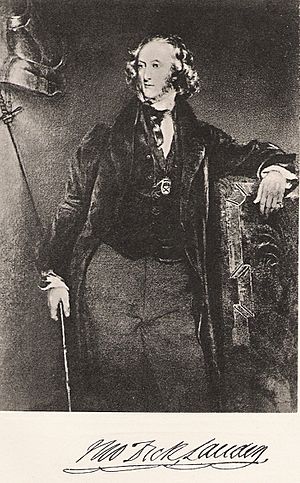Thomas Dick Lauder facts for kids
Sir Thomas Dick Lauder (born August 13, 1784 – died May 29, 1848) was an important Scottish writer and public servant. He held several key positions, including Secretary for the Board of Manufactures and the Herring Fisheries Board. He also served as a Deputy Lieutenant for two Scottish counties, Moray and Haddington. Sir Thomas was the only son of Sir Andrew Dick-Lauder, whom he succeeded as a Baronet in 1820.
Early Life and Career
Sir Thomas Dick Lauder was born in Edinburgh, Scotland, on August 13, 1784. His parents were Elizabeth Brown and Sir Andrew Lauder. He was baptized a few days later near his family's home, Fountainhall.
When he was young, Sir Thomas joined the army. Later, he moved to his wife's home, 'Relugas,' in Morayshire, where he lived until 1832. After that, he moved to Grange House in Edinburgh, where he stayed until he passed away.
In 1839, Sir Thomas became the Secretary for the Board of Manufactures and Fisheries in Scotland. This board helped promote industries and fishing in the country. He also became Secretary for the Board of British White Herring Fishery, which focused on herring fishing. He worked hard in these roles until he became ill. For a time, he was also Secretary for the Royal Institution for the Encouragement of the Fine Arts, which supported art. He was also a member of the Royal Society of Edinburgh, where he shared his ideas about the "Parallel Roads of Glen Roy" in 1818.
Family Life
On February 8, 1808, Sir Thomas married Charlotte Anne Cumin (1785–1864) near the Findhorn River in Moray. Charlotte Anne was the only child and heir of George Cumin of Relugas. Together, they had ten children: eight daughters and two sons.
Political Views
Sir Thomas was a strong supporter of the Liberal political party. He was good friends with Henry Thomas Cockburn, a famous Scottish judge and politician. Sir Thomas was very interested in politics and played an active role.
In 1832, he led a huge meeting of about 30,000 people in Edinburgh. This large gathering supported the Reform Bill, a law that aimed to change how people voted and give more people the right to vote. It was one of the biggest political rallies ever held in Scotland.
His Writings and Books
Sir Thomas and his family were close friends with the famous writer Sir Walter Scott. In 1817, Sir Thomas wrote a story called Simon Roy, Gardener at Dunphail for Blackwood's Magazine. Some people first thought Sir Walter Scott had written it because it was so good!
In 1825 and 1827, Sir Thomas published two adventure stories: Lochandhu and The Wolf of Badenoch. He often wrote for popular magazines like Blackwood's Magazine and Tait's Magazine. In 1830, he published An Account of the Great Floods in Morayshire in 1829. This book described a terrible flood that damaged his beloved home, Relugas house, and he included his own drawings in the book.
Sir Thomas also helped promote the Sobieski Stuart brothers, who later published a book called Vestiarium Scoticum in 1842, which contained some disputed tartan designs. Sir Thomas copied a famous old document called the Cromarty MS. This document stayed with his family until 1936, when it was given to Queen Mary and is now at Windsor Castle. Sir Thomas and Sir Walter Scott discussed this document a lot.
Some of Sir Thomas's other books include:
- Highland Rambles (1837)
- Legendary Tales of the Highlands (1841)
- Tour round the Coasts of Scotland (1842)
Queen Victoria even asked him to write the official history of her visit to Scotland, which was called Memorial of the Royal Progress in Scotland (1843). He also helped prepare a book about natural history in 1833. A series of his unfinished writings about Scottish rivers was published after his death in 1874.
Death and Legacy
Sir Thomas Dick Lauder passed away on Monday, May 29, 1848, at his home, Grange House. He was buried in a new family plot in Grange Cemetery in Edinburgh. His eldest son, Sir John Dick-Lauder, became the 8th Baronet after him.
The Lauder tartan, a special Scottish plaid pattern, first appeared around this time in the Vestiarium Scoticum book. You can find it in books about Scottish tartans.



